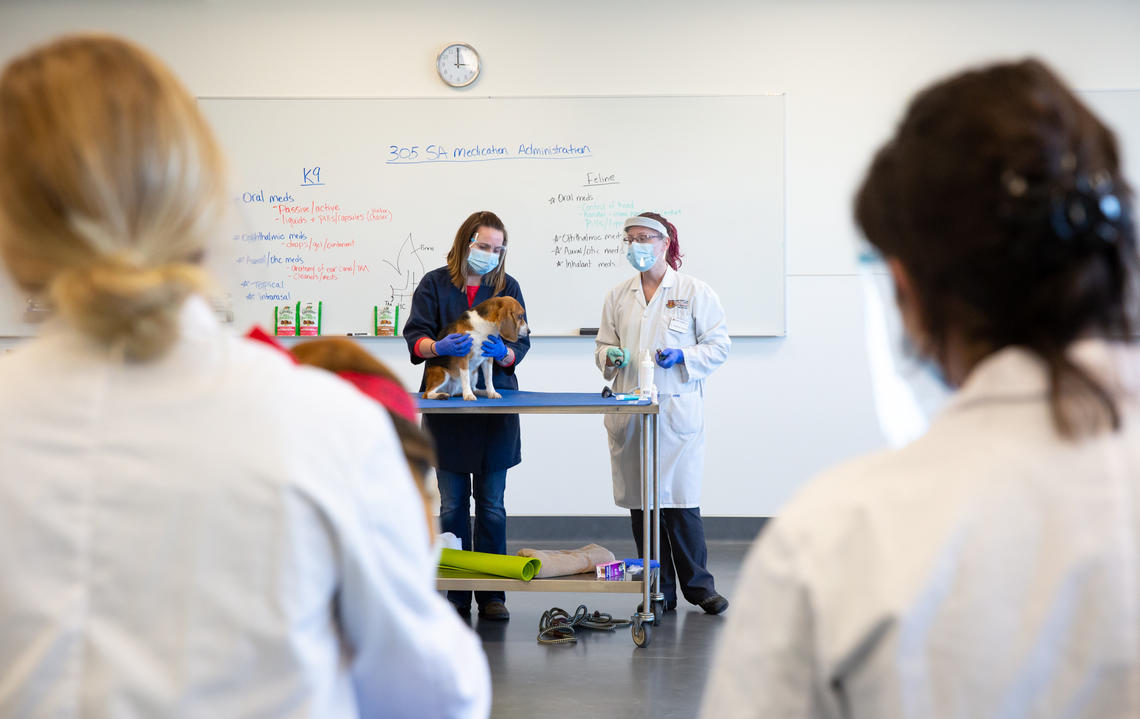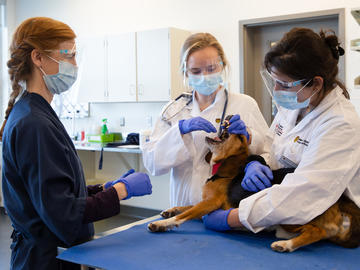March 17, 2021
How to teach veterinary medicine in COVID-19 times

In this pandemic year, teaching students in the highly hands-on UCalgary Doctor of Veterinary Medicine (DVM) program has required some radical changes in approach. In the first of a two-part series, we look at how DVM students are safely being taught clinical skills during in-person labs.
We asked Dr. Rebecca Archer, DVM, a clinical instructor of small animal medicine in UCVM’s Department of Veterinary Diagnostic and Clinical Science a few questions.

Rebecca Archer, right, and clinical teaching support technician Tanya Sooley instructing a class of first-year year vet med students on administering various medications — oral, aural, intranasal, ophthalmic, and topical.
Riley Brandt, University of Calgary
Q: What challenges have you faced in adapting clinical skills labs to comply with COVID-19 protocols?
As COVID progressed, rules and guidelines also changed. One of the most difficult things has been keeping up with those changes and modifying protocols as we get new information. While things have been stable for a little while now, at the beginning some decisions had to be made rapidly and modifications needed to happen fairly frequently.
Q: What kind of modifications were needed?
First, we needed to have fewer students in a lab at a time. Instead of dividing the classes into two groups as we did before, we divide them into three smaller groups to make it easier to have six feet of space in between students. That meant the labs had to be shortened. While we originally planned this change to take effect for our expanded first-year class, the pandemic response meant that we instituted the plan immediately across all three years.
In our labs with dogs and cats, we still have small groups of students working together because working with animals you need someone as a holder. Figuring out how to keep the timing interaction down and the spacing appropriate has been interesting. We also instituted PPE above and beyond what the university requires. Students not only wear a procedure mask in the labs, but they also wear gloves and face shield, and either lab coat or coveralls. We just feel that we are making our students safer.
Q: Along with the changes made to ensure student safety, how else have the labs changed?
Between each lab, everything needs to be sanitized and equipment changed over for the next group. The teaching technicians only have half an hour between labs one and two, so it’s a very quick turnaround. Also, when we're dealing with live animals, they need some down time and a chance to go out for a bathroom break and have a little bit of a walk.
Q: How much of a challenge is it to reset everything with three labs a day?
You know what? The techs are phenomenal. And the students are also helpful in the cleanup process. Everybody has come together and recognized that you don't just run away at the end of lab, because there's work to be done. And the setup is something we had to tweak. We had different timing of the labs at the beginning of the year, and the techs let us know they just couldn't manage that. So, a month in, we changed the lab timing to make it easier on everybody to get that change over done. But really, it's everybody helping that makes it work.
Q: With shortened labs, how do students learn the same amount they used to in longer labs?
Instead of doing live demonstrations and lectures in the lab with the students there, we had a videographer help us create videos of our demos and our pre-lab lectures. That involved a fair bit of pre-planning and a lot of running around and organizing. The students watch those ahead of time before coming into lab, so that we still have enough time to cover all the material within two hours. These changes had been in the works for our first-years, so a lot of thought had gone into best teaching practices. Short sessions keep the lab focused on practicsng the skills without information overload!
Q: How have these modifications impacted the way you teach, and the students learn?
It’s still six hours of teaching a day, but you're doing it three times instead of two. So even though you're technically teaching the same amount it’s mentally a bit exhausting. And everybody had to get used speaking louder, or dealing with the microphone, because my goodness, it's really hard to hear anything in a big lab, with everybody in face shields and face masks. So that's a challenge. We all probably need voice lessons on projection.
But I do think that there's been some surprise advantages to the things that we've put in place. After those changes to the program and implementing all the COVID restrictions, we've seen some nice successes. Shorter labs are better in line with pedagogical best practices. What we found is our students are actually retaining things a bit better. The fact that they have to have watched all the demos and the lecture ahead of lab, means they're coming to lab a lot more prepared.
Q: After all the effort, is there some satisfaction in having pulled this off?
Oh, yes. There was a lot of pessimism about whether or not it was even possible when we first started to put this year together. But you know, we've done it. We're almost at the end, and I couldn't be more proud of my team for that











